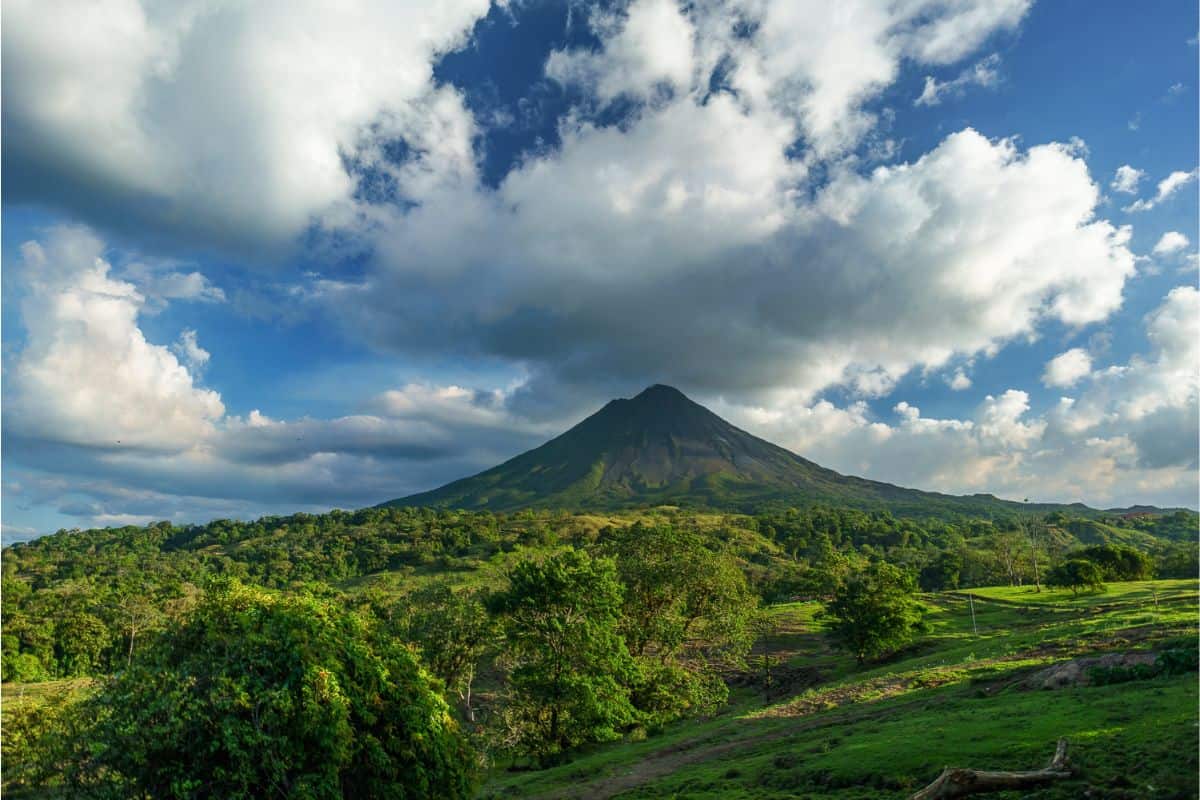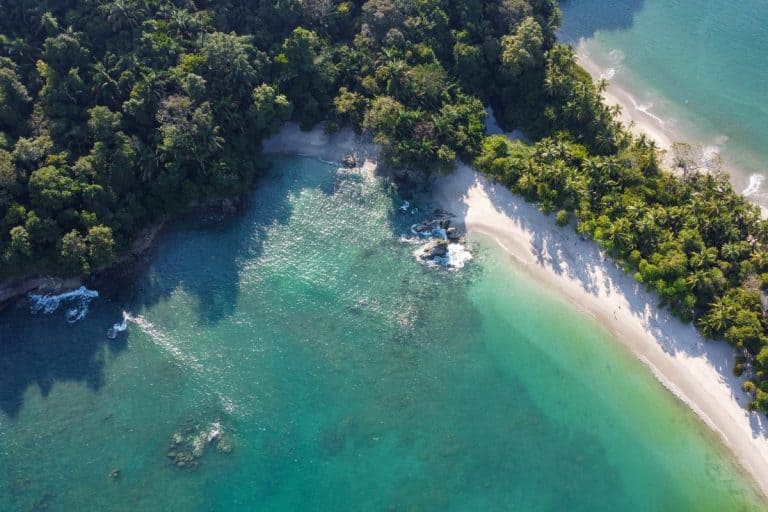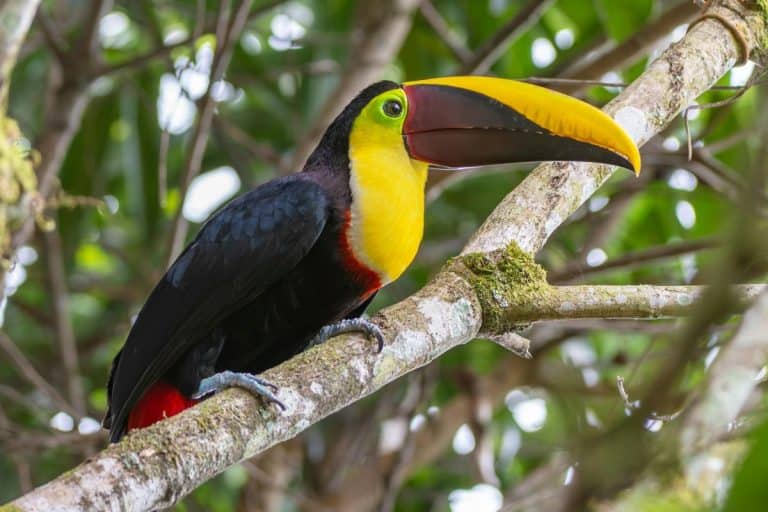Costa Rica Rainy Season: Travel Guide for May to November

Think Costa Rica’s rainy season means a ruined vacation? Think again!
The Costa Rica rainy season, or “green season”, has more to offer than just rain.
Lush landscapes, active wildlife, fewer crowds, and significantly lower prices are just a few of the benefits of visiting at this time of year.
We’ve visited Costa Rica several times throughout the years during both the dry season and the rainy season so we can definitely give you all the pros and cons for both.
That being said, we actually prefer to visit during “green season” for several reasons and we’re going to share those with you along with our top tips for visiting at this time of year!
Costa Rica Rainy Season Highlights
- Lush Green Landscapes – Forests and valleys burst with vibrant greenery.
- Fewer Tourists – Enjoy quieter beaches, trails, and attractions.
- Lower Prices – Off-season rates on hotels, tours, and flights.
- Great Wildlife Watching – Sea turtle nesting (e.g., Tortuguero & Ostional) and active rainforest animals.
- Green Season Surf – Bigger swells on the Pacific coast, especially in Dominical and Pavones.
- Rainforest Adventures – Waterfalls at their best, and rivers ideal for white-water rafting.
- Afternoon Showers – Mornings are usually sunny; rain often comes in bursts later in the day.
- Amazing Pictures – Moody skies, dramatic sunsets, and misty mountains.
Plan Your Trip With Our Favorite Resources
– Best accommodation site: Booking.com
– Book day tours here: Viator.com

Where to Stay in Monteverde, Costa Rica:
6 Standout Stays
Are you struggling with trying to figure out which hotels in Monteverde are the best? Check out our post where we give you our top picks!
READ MORE
Visiting Costa Rica in the Rainy Season
While Costa Rica is famous for its dry season weather, the rainy season (also called “green season”) reveals a completely different side of this tropical paradise.
The beautiful green landscapes and budget-friendly travel are just a couple of reasons that make visiting during the green season worthwhile.
This is our favorite time to visit Costa Rica but we highly recommend being strategic about when in the rainy season you visit.
To be honest, we wouldn’t recommend visiting in September or October unless you’re planning to visit the Caribbean coast.
Here’s our complete month-by-month guide to Costa Rica’s underrated green season!
May: The Perfect Shoulder Season
May marks the start of Costa Rica’s green season and it’s one of the most underrated times to visit.
As the dry season fades and occasional rains return, the landscape begins to bounce back into vibrant green and crowds start to thin dramatically.
Because the dry season has just ended, May is a bit of a transitional month rather than a full-on change to the rainy season. This makes it a great time to visit especially if you’re hoping to spend some time on the Pacific Coast.
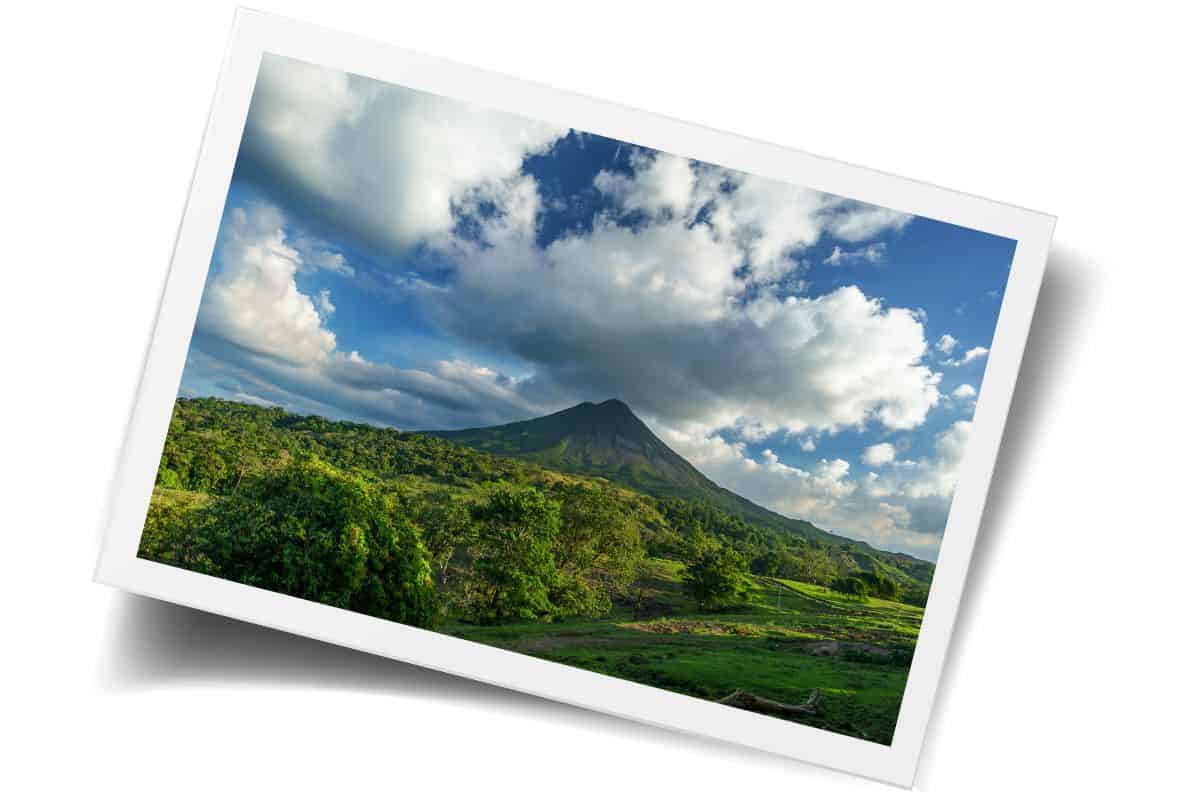
Weather
The Pacific Coast and Central Highlands experience a gradual transition during May, with mornings often remaining dry while short, refreshing afternoon rains begin to revive the landscape.
The Caribbean coast tends to be relatively dry compared to other months.This means there will be excellent beach conditions so if you’re hoping to visit both coasts, this is the ideal time to do it.
Quick Weather Facts For May
- Temperatures – Stay comfortable at 75–90°F (24–32°C) across most regions
- Rainfall – Light afternoon showers, especially later in the month
- Sunshine Hours – 6-7 hours per day, mostly in morning
- Daylight Hours – 12 hours
- Humidity – Rising slightly in jungle regions
- Water Temperature – Mid 80s
Crowds
May experiences a dramatic decrease in visitor numbers with the end of winter weather in other parts of the world.
This creates a much quieter atmosphere throughout the country but especially in popular places such as Guanacaste, Arenal and Manuel Antonio.
May Events and Festivals
May brings a quieter atmosphere throughout the country but there are a couple of notable cultural events that take place.
- Labor Day (May 1st) – brings colorful parades and community events throughout the country.
- Fiestas Cívicas – featuring traditional rodeos and music.
Top Tips For Visiting In May
May is a great introduction to green season travel because it combines reasonable weather with significant cost savings and fewer crowds.
Be sure to plan outdoor activities during the morning hours when the weather is the most reliable and embrace the afternoon rains as a refreshing break from the heat.
May Quick Tips At A Glance
What To Pack
- Quick-Dry Clothing – Lightweight fabrics that handle occasional moisture
- Rain Jacket – Essential for afternoon showers
- Waterproof Shoes – For wet trails and streets
- Insect Repellent – Mosquito activity increases with rains
- Waterproof Bags – Protect electronics from unexpected downpours
- Light Layers – Mornings can be cooler after night rains
Where To Go
- National Parks – Wildlife viewing reaches excellent levels with active animals
- Beach Destinations – Fewer crowds and lower prices, morning beach time ideal
- Adventure Activities – Continue with smaller, more personalized group sizes
- Central Valley – Emerald green landscapes perfect for photography
- Cloud Forests – Monteverde shows increased bird activity
Know Before You Go
- Great Value – Accommodations and tours cost 20–40% less than high season
- Morning Activities – Most reliable weather before afternoon rains
- Wildlife Active – Animals become significantly more active
- Flexible Booking – Easy last-minute reservations due to lower demand
June: Heart of the Green Season
June starts to get into the heart of the green season when rainforests truly live up to their name.
The lush vegetation and fewer tourists make it ideal for exploring at your leisure. There’s still some surprisingly good weather windows so you can still fully enjoy everything Costa Rica has to offer without worrying about inclement weather.
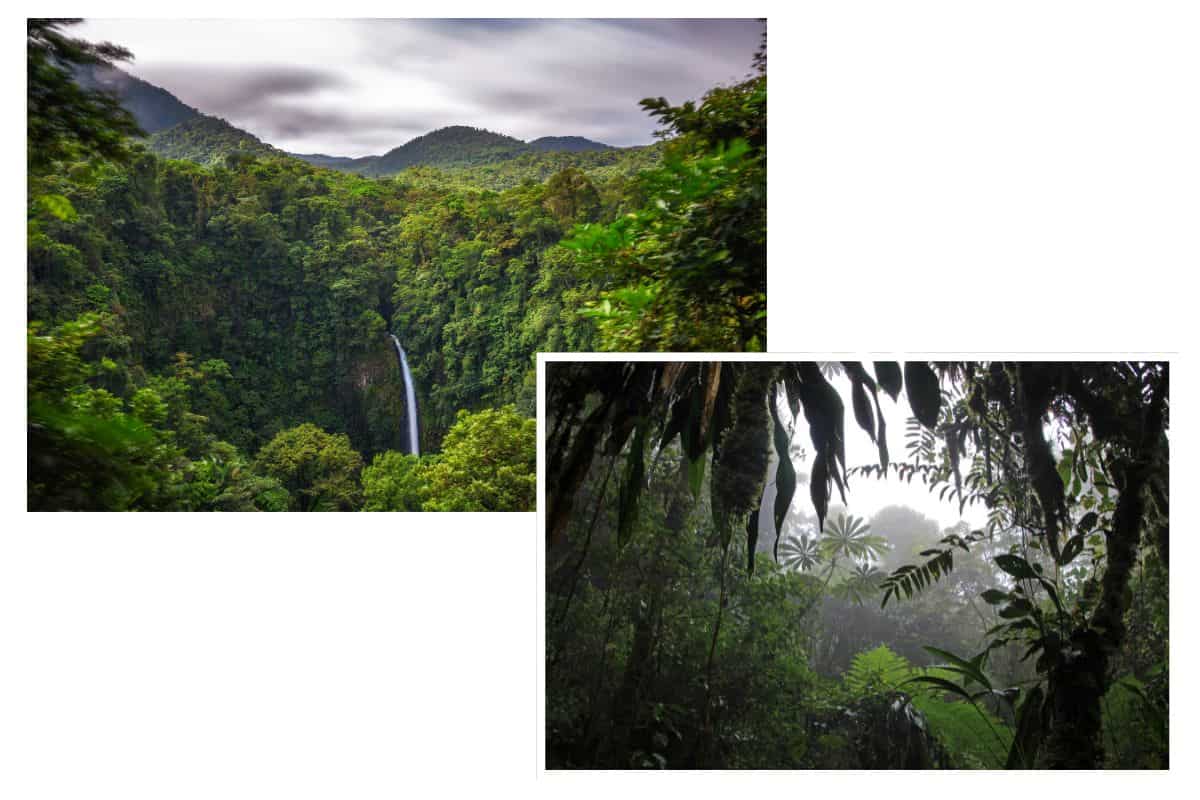
Weather
The Pacific Coast and Central Highlands start to settle into predictable weather patterns in June.
The norm is usually sunny mornings followed by mid-to-late afternoon rains that rarely last all day.
Interestingly, the Caribbean Coast often experiences drier conditions, particularly in Tortuguero and Puerto Viejo so this is a perfect time to visit some of the great eco-lodges those areas offer.
Quick Weather Facts For June
- Temperatures – Range from 75–88°F (24–31°C) with comfortable conditions
- Rainfall – Daily afternoon showers, mornings typically dry
- Sunshine Hours – 5-6 hours per day, concentrated in morning
- Daylight Hours – 12.5 hours
- Humidity – Moderate to high, especially in coastal regions
- Water Temperatures – Low to mid 80s
Crowds
June continues the peaceful atmosphere of green season with the tourist levels still declining.
This makes it perfect for exploring some of the small beach towns that would normally be very crowded during the dry season.
June Events and Festivals
June is a mostly quiet month for events in Costa Rica however, there are a couple of religious events.
This month also marks the return of the green sea turtle nesting on the Caribbean coast.
- Corpus Christi and Día de San Pedro y San Pablo (June 29) – bring religious celebrations to various towns.
- Green sea turtles begin nesting – on the Caribbean coast, especially in Tortuguero National Park.
Top Tips For Visiting In June
June can be a perfect time to visit especially for anyone that wants a vacation that’s part adventure and part relaxation.
The predictable weather patterns make planning easier so you can spend your mornings exploring and your afternoons reading a good book or enjoying a yoga class or spa treatment.
June Quick Tips at a Glance
What To Pack
- Waterproof Gear – Rain jackets and waterproof shoes essential
- Quick-Dry Clothing – Handles humid conditions and occasional wet weather
- Strong Insect Repellent – Critical for increased mosquito populations
- Dry Bags – Protect camera equipment and electronics
- Light Cotton Clothing – Breathable fabrics for humid conditions
- Waterproof Watch – Track weather patterns and activity timing
Where To Go
- Caribbean Coast – Tortuguero and Puerto Viejo offer drier conditions
- National Parks – Fully accessible with active wildlife and lush scenery
- Turtle Nesting Sites – Green sea turtle season begins
- Hiking Trails – Morning hikes in peak green conditions
- Surfing Spots – Strong rainy-season swells on both coasts
Know Before You Go
- Predictable Patterns – Sunny mornings, afternoon rains
- Low Season Pricing – Continued savings on accommodations
- Peak Lushness – Landscapes at their most vibrant
- Wildlife Active – Animals take advantage of cooler, wetter conditions
July: The “Little Summer”
July offers a fantastic Costa Rica experience thanks to its unique “Mini Dry Season” (Veranillo de San Juan), combining nice weather with fewer crowds.
This natural phenomenon makes July one of the most pleasant green season months and one of our favorite times to visit.
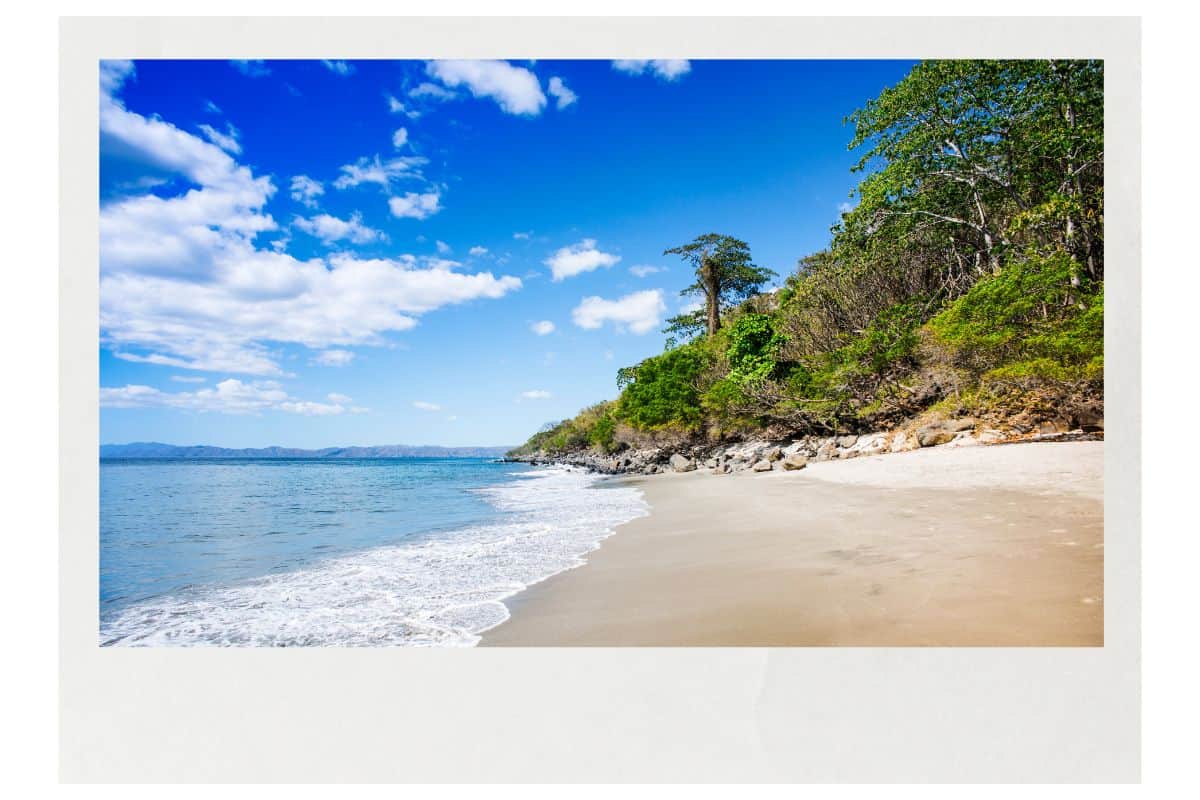
Weather
Many Pacific coast areas experience a notable break in rainfall during early to mid-July, creating conditions that feel like an extension of dry season mixed with green season beauty.
The Central Valley maintains comfortable conditions while the Caribbean coast sees more consistent rain.
Quick Weather Facts For July
- Temperatures – Central Valley 70–80°F (21–27°C), Pacific 80–90°F (27–32°C), Caribbean 75–85°F (24–29°C)
- Rainfall – Reduced during “veranillo,” shorter afternoon showers
- Sunshine Hours – 6-8 hours per day during mini dry season
- Daylight Hours – 12.5 hours
- Humidity – Moderate, comfortable for outdoor activities
- Water Temperatures – Low to mid 80s
Crowds
In July, Costa Rica experiences moderate tourist crowds, especially compared to the peak season months of December through April.
While some popular destinations like Arenal, Monteverde, and parts of the Pacific Coast still attract visitors, the overall atmosphere tends to be more relaxed and less crowded.
Additionally, Costa Rican school holidays usually occur in early to mid-July, which can lead to a temporary increase in local tourism at beaches and national parks.
Despite this, July often strikes a nice balance between activity and tranquility, making it a favorable time for travelers seeking fewer crowds and lower prices.
July Events and Festivals
July has a couple of notable local festivals if you happen to be staying near Puntarenas or on the Nicoya Peninsula.
- Virgen del Mar Festival – in mid-July transforms Puntarenas with colorful boat parades, music, and fireworks.
- Annexation of Guanacaste Day on July 25th – parades, rodeos, and traditional music, particularly vibrant in Liberia and Nicoya.
Top Tips For Visiting In July
July’s “little summer” weather pattern makes it one of the most pleasant green season months for travelers seeking a balance of lush landscapes and reliable morning weather.
Be sure to schedule outdoor activities in the morning to ensure a better chance of better weather.
July Quick Tips at a Glance
What To Pack
- Versatile Clothing – Prepare for both sunny and rainy conditions
- Strong Insect Repellent – Critical during July’s increased wildlife activity
- Waterproof Shoes – Essential for wet trail conditions
- Sun Protection – Important during veranillo sunny periods
- Quick-Dry Fabrics – Handle changing weather conditions
- Light Rain Gear – For occasional afternoon showers
Where To Go
- Guanacaste Province – Benefits most from mini dry season conditions
- National Parks – Sea turtle nesting, surfing, hot springs excellent
- Cultural Festivals – Puntarenas and Liberia offer authentic celebrations
- Adventure Activities – River rafting continues with good conditions
- Wildlife Viewing – Birds, frogs, sea turtles particularly active
Know Before You Go
- Mini Dry Season – More reliable weather than other green season months
- Cultural Celebrations – Authentic festival experiences available
- Wildlife Peak – Excellent conditions for animal viewing
- Flexible Weather – Prepare for both sunny and rainy conditions
August: Caribbean Coast’s Best Month
August is firmly within the rainy season for most of the country but it offers unique advantages for anyone that visits the Caribbean coast which starts to see some fantastic weather conditions.
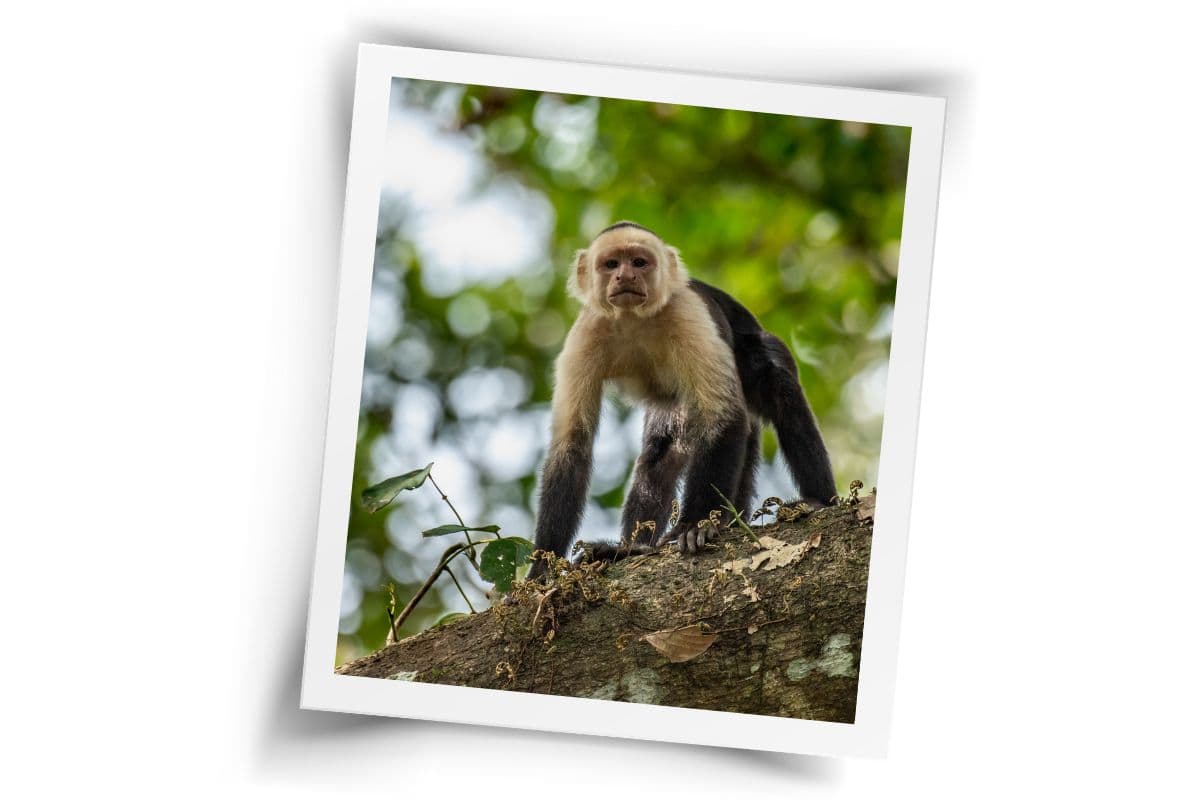
Weather
The Pacific coast often continues benefiting from July’s “mini dry season” effects into early August, with sunny mornings and manageable afternoon rains.
The Caribbean coast experiences one of its driest months, making destinations like Tortuguero and Puerto Viejo ideal destinations.
Quick Weather Facts For August
- Temperatures – Central Valley 70–80°F (21–27°C), Pacific 80–90°F (27–32°C), Caribbean 75–85°F (24–29°C)
- Rainfall – Pacific: regular afternoon showers; Caribbean: minimal rainfall
- Sunshine Hours – 5-6 hours Pacific, 7-8 hours Caribbean coast
- Daylight Hours – 12.5 hours
- Humidity – High in Pacific regions, comfortable on Caribbean coast
- Water Temperatures – Low to mid 80s
Crowds
August maintains a quiet atmosphere with reduced tourist numbers creating uncrowded national parks and beaches.
August Events and Festivals
The most notable events of August include the Virgin of Los Angeles Day and Mother’s Day, two of the more celebrated events of the year.
- Virgin of Los Angeles Day (August 2nd) – represents Costa Rica’s most important religious holiday with pilgrims walking to Cartago.
- Mother’s Day (August 15th) – brings family gatherings nationwide.
Top Tips For Visiting In August
While other parts of the country are in the heart of the rainy season, August offers strategic advantages for travelers who focus on the Caribbean coast during its optimal weather period.
Some of the small eco lodges on the Caribbean coast are ideal destinations for anyone hoping to get in some great wildlife viewing.
August Quick Tips At A Glance
What To Pack
- Regional Clothing Strategy – Light beach gear for Caribbean, rain gear for Pacific
- Excellent Insect Repellent – Essential for increased wildlife activity
- Waterproof Footwear – Critical for navigating wet conditions
- Dry Bags – Protect electronics during travel between regions
- Sun Protection – Important for Caribbean coast sunny conditions
- Quick-Dry Everything – Handles humid, wet Pacific conditions
Where To Go
- Caribbean Beaches – Puerto Viejo, Cahuita offer perfect sunny conditions
- Tortuguero – Peak sea turtle nesting season with ideal weather
- Arenal Hot Springs – Perfect rainy-day alternative
- Monteverde – Mystical cloud forest conditions
- Pacific Surfing – Excellent swells despite afternoon rains
Know Before You Go
- Regional Strategy – Caribbean coast ideal, Pacific manageable
- Peak Wildlife – Sea turtle nesting reaches peak season
- Cultural Celebrations – Important religious and family holidays
- Weather Contrasts – Dramatic differences between coasts
September: The Caribbean Coast’s Prime Time
September presents fascinating regional contrasts, offering hidden opportunities for travelers who understand where to focus attention.
While the Pacific side experiences heavy rains, the Caribbean coast enjoys its sunniest, driest weather of the entire year.
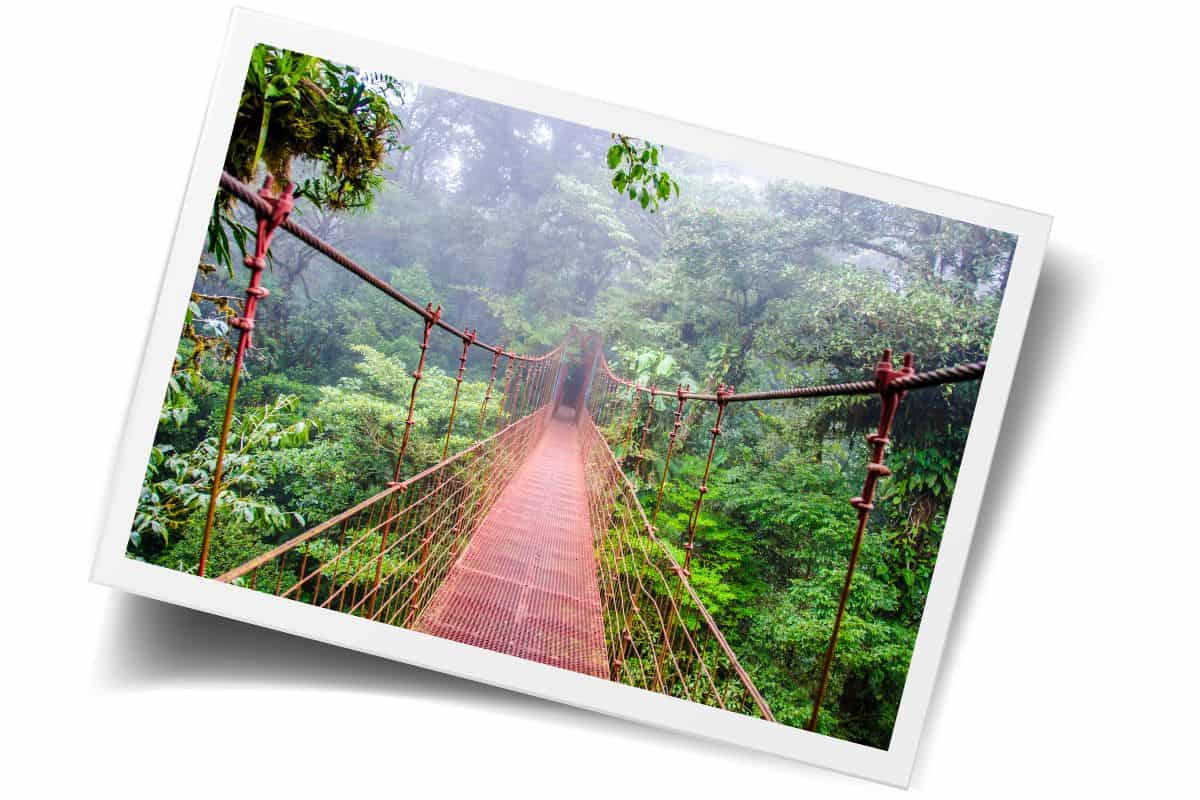
Weather
Anyone visiting Costa Rica in September will see its most pronounced weather contrast of the year.
Pacific areas experience one of their wettest months with heavy afternoon and evening rainfall, while the Caribbean coast enjoys sunny days with calm seas.
The Central Valley sees regular afternoon rain patterns.
Quick Weather Facts For September
- Temperatures – Pacific 80–88°F (27–31°C), Caribbean 78–88°F (26–31°C), Central Valley 70–80°F (21–27°C)
- Rainfall – Pacific: heavy daily rains; Caribbean: minimal, sunny conditions
- Sunshine Hours – Pacific 3-4 hours, Caribbean 8-9 hours per day
- Daylight Hours – Around 12 hours
- Humidity – High Pacific side, comfortable Caribbean coast
- Water Temperature –
Crowds
September experiences the year’s lowest tourist numbers which isn’t surprising considering it’s one of the wettest months of the year throughout a good portion of the country.
Visiting at this time of year doesn’t require a lot of advance planning so if you’re not bothered by heavy rainfall and want to be spontaneous, you should have no trouble at all booking a last-minute trip in September.
September Events and Festivals
This is a fairly quiet month for events however Independence Day takes place mid-month and leads to celebrations around the country.
Independence Day (September 15th) – creates significant cultural celebrations throughout the country with parades, folk music, lantern processions, and traditional dress.
Top Tips For Visiting In September
September is for strategic travelers who focus on the Caribbean coast during its optimal weather period.
The Pacific coast will have less ideal weather conditions but will have some of the lowest prices and crowds of the year creating exceptional value for budget travelers.
September Quick Tips At A Glance
What To Pack
- Comprehensive Rain Gear – Essential for any Pacific coast activities
- Beach Equipment – Perfect Caribbean coast conditions
- Waterproof Everything – Shoes, bags, clothing for Pacific regions
- Versatile Clothing – Handle dramatic regional weather differences
- Strong Insect Repellent – Peak wildlife activity increases mosquito populations
- 4WD Considerations – Some roads become challenging
Where To Go
- Caribbean Beaches – Puerto Viejo, Cahuita offer perfect conditions
- Tortuguero – Continued turtle nesting with ideal weather
- Independence Celebrations – Cultural experiences throughout country
- Wildlife Photography – Peak activity levels for exceptional shots
- Caribbean Water Sports – Optimal conditions for diving, snorkeling
Know Before You Go
- Regional Planning – Caribbean focus essential for best weather
- Lowest Prices – Annual minimum rates for accommodations and tours
- Cultural Celebrations – Independence Day provides authentic experiences
- Road Conditions – Pacific areas may have challenging access
October: The Wettest Month
September may be wet but October wins the prize for Costa Rica’s wettest and quietest month.
Strategic travelers can still find amazing experiences by focusing on the Caribbean coast which enjoys a mini dry season while the rest of the country experiences peak rainfall.
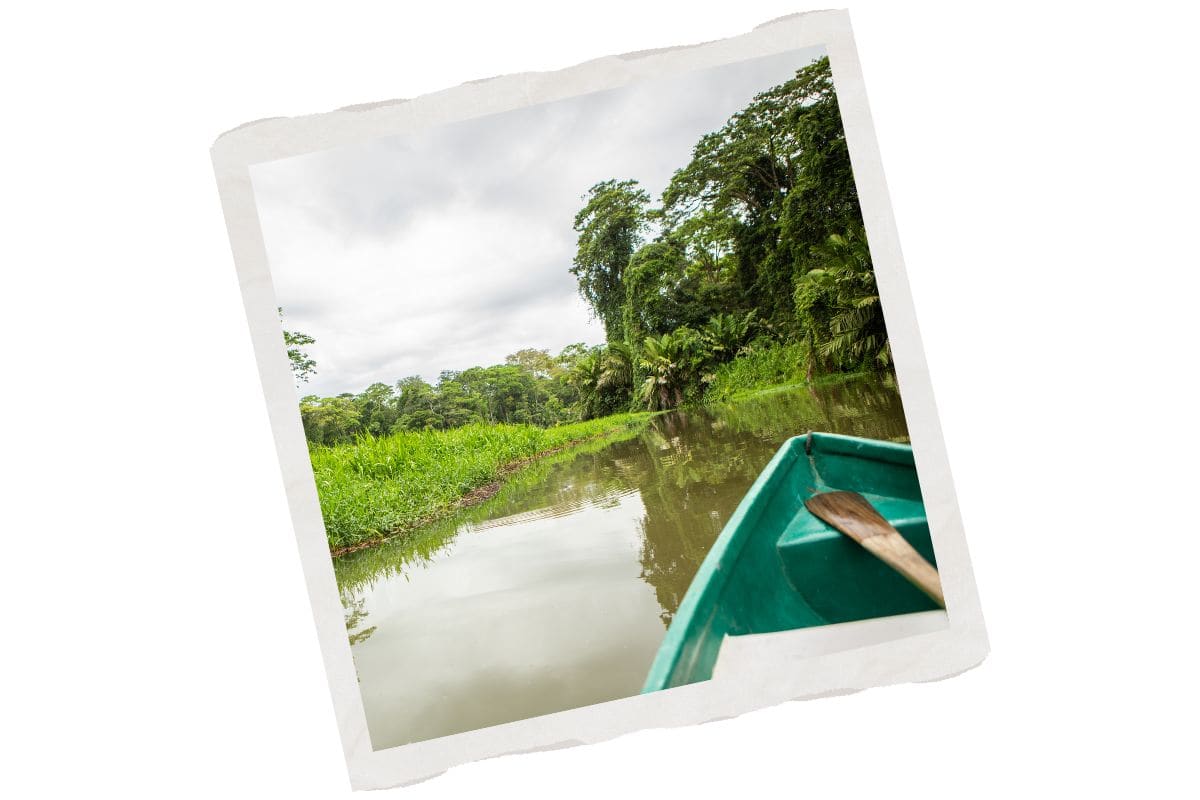
Weather
October brings the year’s wettest conditions for most of Costa Rica, particularly affecting Pacific coast and mountainous regions with consistent rainfall. However, the Caribbean coast experiences sunny, warm conditions with this being its driest month.
Quick Weather Facts For October
- Temperatures – Pacific very rainy with muddy conditions, Caribbean 78–88°F (26–31°C) sunny
- Rainfall – Pacific: heavy daily rains; Caribbean: minimal, perfect conditions
- Sunshine Hours – Pacific 2-3 hours, Caribbean 8-9 hours per day
- Daylight Hours – Around 12 hours
- Humidity – Very high Pacific regions, comfortable Caribbean coast
- Water Temperature –
Crowds
October experiences the year’s absolute minimum tourist numbers due to it historically being the rainiest month of the year.
If you’re looking for the month that has the absolute lowest prices and little to no crowds, this is it. The tradeoff is the less than ideal weather you’ll find throughout most of the country.
October Events and Festivals
For all the hearty souls out there that won’t let a little rain ruin a good time, check out the Día de las Culturas celebrations.
Día de las Culturas (October 12th) – celebrates Costa Rica’s cultural diversity, most vibrantly in Puerto Limón with Afro-Caribbean parades, music, dance, and food festivals.
Top Tips For Visiting In October
October requires focusing almost exclusively on the Caribbean coast for optimal weather conditions.
The lowest prices and crowds create exceptional value albeit a soggy one.
October Quick Tips At A Glance
What To Pack
- Comprehensive Waterproof Gear – Essential for any Pacific activities
- Caribbean Beach Equipment – Perfect sunny conditions on eastern coast
- Waterproof Boots – Mandatory for Pacific region travel
- Dry Storage – Multiple waterproof bags for electronics and documents
- Versatile Rain Gear – Ponchos, umbrellas, waterproof clothing
- Insect Protection – Peak mosquito activity requires strong repellent
Where To Go
- Caribbean Beaches – Perfect snorkeling and swimming conditions
- Tortuguero and Gandoca-Manzanillo – Continued sea turtle nesting
- Puerto Limón – Cultural celebrations and perfect weather
- Caribbean Water Activities – Optimal conditions for all marine sports
- Indoor Cultural Sites – Perfect backup activities for rainy Pacific days
Know Before You Go
- Caribbean Focus – Essential strategy for reliable weather
- Lowest Prices – Annual minimum rates across all services
- Cultural Celebrations – Authentic multicultural experiences available
- Access Challenges – Some Pacific areas may be difficult to reach
November: The Transition Month
Much like May, November serves as a transition month, marking the gradual end of rainy season and slow return of tourism.
This period offers ideal conditions for travelers seeking greener landscapes, fewer crowds, and steadily improving weather patterns.
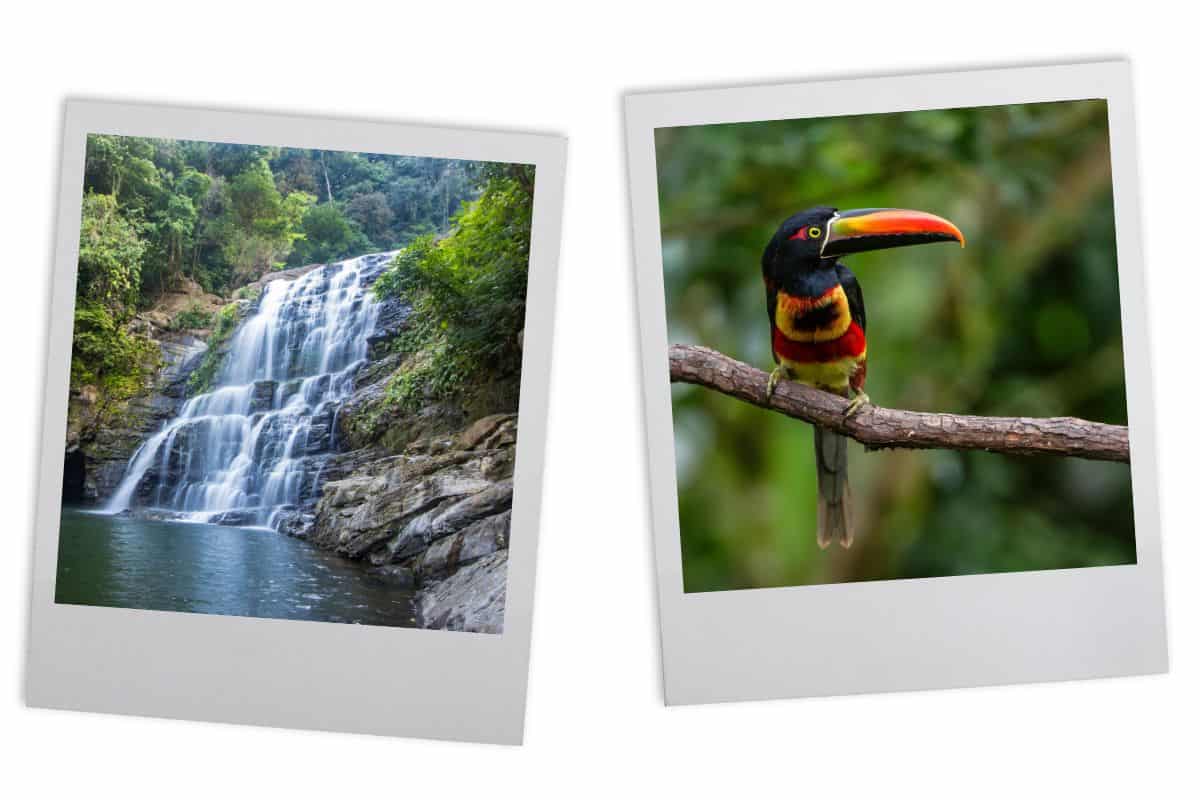
Weather
November marks the beginning of the rainy season’s end, especially in Pacific and Central regions where conditions improve steadily throughout the month.
The Caribbean coast experiences a weather reversal as its dry season ends.
Quick Weather Facts For November
- Temperatures – Comfortable across all regions, Pacific improving daily
- Rainfall – Decreasing on Pacific side, increasing on Caribbean coast
- Sunshine Hours – 5-7 hours per day, increasing through the month
- Daylight Hours –
- Humidity – Moderate and comfortable for outdoor activities
- Water Temperature –
Crowds
With the rain starting to decrease and the dry season right around the corner, November begins to see a gradual increase in tourist numbers.
Even though dry season technically starts in December, the real crowds won’t start to arrive until mid-December. This means that late November into early December is a great time to visit for better weather and less crowds and fairly reasonable prices.
November Events and Festivals
Día de los Santos (November 1st) and Día de los Difuntos (November 2nd) honor saints and deceased family members. Many tourist establishments offer U.S. Thanksgiving meals for international visitors.
Top Tips For Visiting In November
November offers excellent timing for travelers seeking improving weather without dry season crowds and pricing.
Late November provides particularly good conditions as dry season approaches.
November Quick Tips At A Glance
What To Pack
- Versatile Clothing – Handle changing weather conditions
- Light Rain Gear – For early November conditions
- Sun Protection – Increasingly important as weather improves
- Hiking Gear – Trail conditions improving throughout month
- Beach Equipment – Late November becomes ideal for coastal activities
- Flexible Layers – Transitional weather requires adaptable clothing
Where To Go
- Pacific Coast – Surfing becomes increasingly excellent
- National Parks – Rainforest hiking remains rewarding
- Beach Destinations – Late November offers improving conditions
- Wildlife Areas – Animals remain highly active in lush environment
- Cultural Sites – Holiday celebrations begin appearing
Know Before You Go
- Timing Matters – Late November much better than early November
- Transition Pricing – Opportunities for deals before high season
- Weather Improving – Steadily better conditions throughout month
- Booking Flexibility – Still easier than dry season months
Essential Rainy Season Planning Tips
Costa Rica’s rainy season isn’t for everyone, but it can be perfect depending on your travel priorities and flexibility with weather. If you’re seeking guaranteed daily sunshine and completely predictable conditions, the dry season might suit you better.
However, if you value significant cost savings, lush natural beauty, and don’t mind working with tropical weather patterns, the rainy season offers some of Costa Rica’s most rewarding travel experiences.
If you’re committed to visiting during the rainy season, the key to a successful visit is understanding regional weather differences, planning morning activities, and embracing the rain rather than seeing it as an inconvenience.
That said, here are some additional tips and strategies to help you plan an amazing trip!

Regional Strategy
- May-August: Both coasts viable, focus on morning activities
- September-October: Caribbean coast ideal, avoid Pacific side
- November: Pacific coast improves, Caribbean gets wetter
Packing Essentials
- Waterproof jacket and quick-dry clothing
- Insect repellent (mosquito populations increase significantly)
- Sturdy, waterproof footwear for muddy trails
- Dry bags for electronics and important documents
Planning Strategies
- Book flexible accommodations that allow weather-related changes
- Plan morning activities when weather is most reliable
- Consider 4WD vehicle rental for rural or mountainous areas
- Have backup indoor activities for heavy rain days
- Embrace the rain as part of authentic Costa Rica experience
Activity Considerations
- Wildlife viewing reaches peak levels with active animals
- Morning activities provide most reliable weather windows
- Adventure tours operate with smaller, more intimate groups
- Cultural experiences more authentic without tourist crowds
What Makes the Rainy Season Our Favorite Time to Visit?
Our first time visiting Costa Rica was during the rainy season and we absolutely loved it. Since that first visit, we’ve also traveled there during the dry season and, honestly, it didn’t really compare.
The green season has a completely different feel. I think part of this stems from the fact that when we first visited many, many years ago, Costa Rica wasn’t on many people’s radar as a vacation destination.
Fast forward to now and there are very few bucket lists that don’t include this amazing country.
Part of me feels that when we visit during the green season, we get a little bit of that “hidden gem” feeling back that we felt the first time. That and we really don’t like crowds.
However, that’s our opinion. Ultimately, the best time to visit Costa Rica will depend on what works for you.
FAQs: Rainy Season Travel in Costa Rica
If you need some additional straightforward information about visiting Costa Rica in the rainy season, here are our answers to some of the most common questions.
Is it worth going to Costa Rica during rainy season?
Absolutely, especially if you’re strategic about when you go and don’t mind the afternoon showers, the rainy season offers some of Costa Rica’s most spectacular natural beauty.
What is the rainiest month in Costa Rica?
The rainiest months are typically September and October throughout most of Costa Rica. The Caribbean coast is the exception to this because it often experiences drier and sunnier weather during these months.
What’s the cheapest month to go to Costa Rica?
Because September and October tend to be the wettest months of the year throughout most of Costa Rica, these also tend to be the least expensive months to visit.
Final Takeaway: Is the Costa Rica Rainy Season For You?
Costa Rica’s rainy season is what originally hooked us and made us want to visit again. With its emerald landscapes, incredible wildlife and exceptional value, it appealed to us on so many levels.
Obviously, it may not be everyone’s idea of an ideal vacation especially if you’re hoping to fit in a lot of beach time.
However, if you’re open to experiencing Costa Rica during the season that helps to shape its character, the country will reward you ten-fold.
If you decide to visit in the green season, remember to pack waterproof gear, plan morning activities and embrace the rain. You’ll soon discover why the Costa Rica rainy season represents one of Central America’s most rewarding travel experiences for adventurous, flexible travelers.

